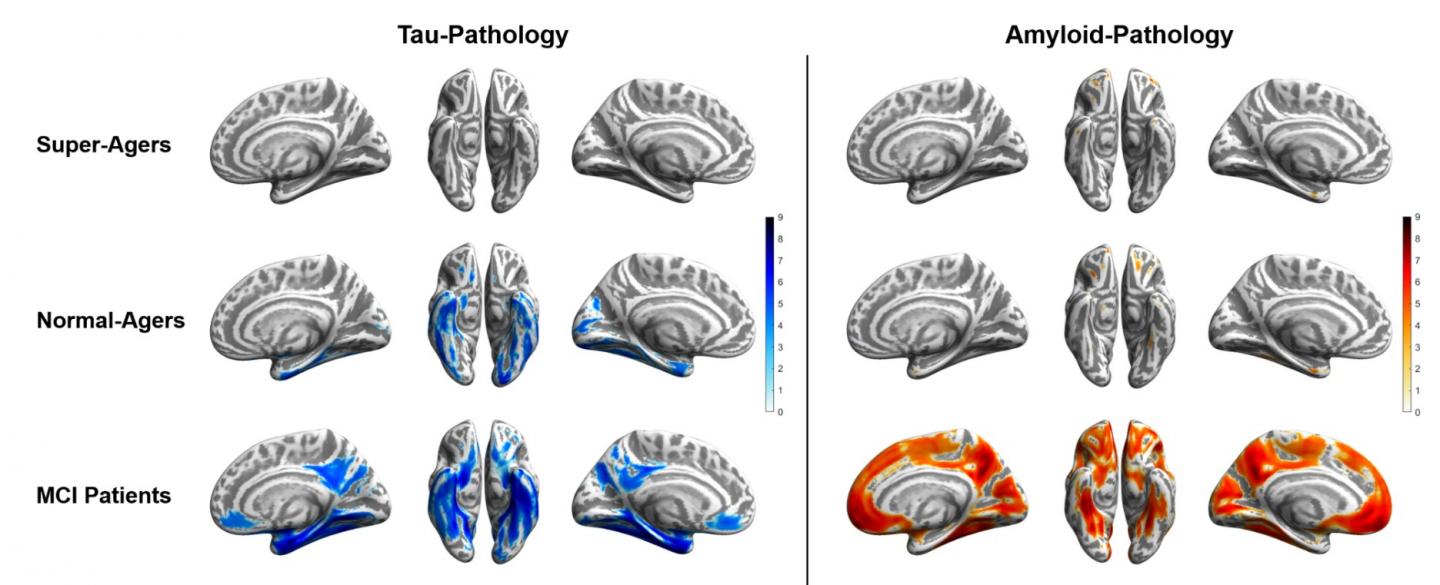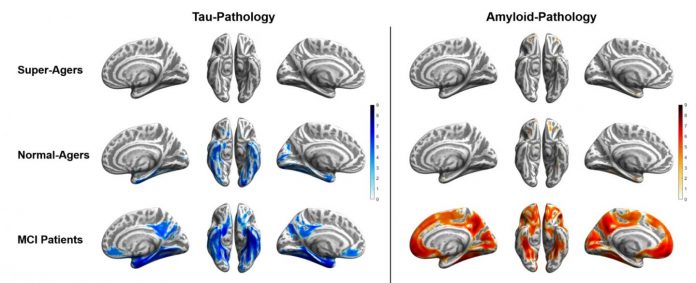
IMAGE: Tau (blue) and amyloid (orange) distribution patterns for super-agers, normal-agers and MCI patients, when compared to a group of younger, healthy, cognitively normal, amyloid-negative individuals. Brain projections are depicted at…
view more
Credit: Merle C. Hoenig, Institute for Neuroscience and Medicine II – Molecular Organization of the Brain, Research Center Juelich, Juelich, Germany, and Department of Nuclear Medicine, University Hospital Cologne, Cologne, Germany.
Super-agers, or individuals whose cognitive skills are above the norm even at an advanced age, have been found to have increased resistance to tau and amyloid proteins, according to research presented at the Society of Nuclear Medicine and Molecular Imaging (SNMMI) 2020 Annual Meeting. An analysis of positron emission tomography (PET) scans has shown that compared to normal-agers and those with mild cognitive impairment, super-agers have a lower burden of tau and amyloid pathology associated with neurodegeneration, which probably allows them to maintain their cognitive performance. An image showing the comparison of tau and amyloid distribution patterns in these different cognitive aging trajectories has been selected as SNMMI’s 2020 Image of the Year.
“Our cognition reflects who we are as individuals. As we age, most of us lose some of that ability,” said SNMMI’s Scientific Program Committee chair, Umar Mahmood, MD, PhD. “The Image of the Year provides us with insight into how we can use these PET imaging biomarkers to understand behaviors and therapies that may allow more of us age better and retain more of our cognitive abilities as we get older.”
Each year, SNMMI chooses an image that best exemplifies the most promising advances in the field of nuclear medicine and molecular imaging. The state-of-the-art technologies captured in these images demonstrate the capacity to improve patient care by detecting disease, aiding diagnosis, improving clinical confidence and providing a means of selecting appropriate treatments. This year, the SNMMI Henry N. Wagner, Jr., MD, Image of the Year was chosen from more than two thousand abstracts submitted to the meeting and voted on by reviewers and the society leadership.
“The phenomenon of super-aging suggests that cognitively high-functioning individuals have extraordinary mechanisms that resist brain aging processes and neurodegeneration,” said Dr. Merle Hoenig, Research Center Juelich & University Hospital Cologne, Germany. Some insights have been collected on amyloid pathology in super-agers, but there is no in vivo evidence on tau pathology due to the former lack of available imaging techniques. “We know that tau pathology is more closely associated with cognitive decline than amyloid pathology,” Hoenig continued, “thus, the resistance, in particular against tau pathology, likely allows these individuals to perform cognitively above average even at advanced age.”
Data from the Alzheimer’s Disease Neuroimaging Initiative was utilized to create three age- and education-matched groups of 25 super-agers, 25 normal-agers and 25 patients with mild cognitive impairment, all above 80 years old. In addition, 18 younger, cognitively normal, amyloid-negative controls were included in the comparison as a reference group. 18F-AV-1451 and 18F-AV-45 PET images obtained for all individuals and researchers compared the tau and amyloid burden between the four groups. A logistic regression was performed to identify genetic and pathophysiological factors best predicting aging processes.
No significant differences between super-agers and the younger control group were observed in terms of in vivo tau and amyloid burden. The normal-ager group exhibited tau burden in inferior temporal and precuneal areas and no significant differences in amyloid burden, when compared to the younger control group. Patients with mild cognitive impairment showed both high amyloid and high tau pathology burden. Differences in amyloid burden dissociated the normal-agers from those with mild cognitive impairment, whereas lower tau burden and lower polygenic risk predicted super-agers from mild cognitive impairment patients.
“While super-agers may be able to resist aging-associated proteinopathies, in particular tau pathology, normal-agers may not and are thus exposed to inevitable cognitive decline due to the accumulation of neurotoxic tau tangles and the advancing aging process,” noted Hoenig. “Moving further to the other extreme of aging, namely mild cognitive impairment, the synergistic effects of both amyloid and tau may accelerate the pathological aging process.”
These results motivate further research to determine responsible resistance factors, which may also inspire the development of novel treatment concepts. “Given the multitude of factors involved in the aging process, it will certainly be challenging to develop therapeutics to tackle the factors involved. However, if we understand which individuals are resistant to dementia, this will help us identify potential pathways that promote successful aging–protecting against not only Alzheimer’s disease but also other aging-associated diseases, such as vascular disease and other forms of dementia,” said Hoenig.
###
Abstract 20. “Resistance to Tau and Amyloid Pathology Facilitates Super-Aging,” Merle C. Hoenig, Institute for Neuroscience and Medicine II – Molecular Organization of the Brain, Research Center Juelich, Juelich, Germany, and University Hospital Cologne, Cologne, Germany; Gérard N: Bischof and Niclas Willscheid, University Hospital Cologne, Cologne, Germany; Thilo van Eimeren, University Hospital Cologne, Cologne, Germany, and German Center for Neurodegenerative Diseases Bonn/Cologne, Germany; Alexander Drzezga, University Hospital Cologne, Cologne, Germany, Institute for Neuroscience and Medicine II – Molecular Organization of the Brain, Research Center Juelich, Juelich, Germany, and German Center for Neurodegenerative Diseases Bonn/Cologne, Germany; for the Alzheimer’s Disease Neuroimaging Initiative.
To schedule an interview with the researchers, please contact Rebecca Maxey at (703) 652-6772 or [email protected]. All 2020 SNMMI Annual Meeting abstracts can be found online at http://jnm.
About the Society of Nuclear Medicine and Molecular Imaging
The Society of Nuclear Medicine and Molecular Imaging (SNMMI) is an international scientific and medical organization dedicated to advancing nuclear medicine and molecular imaging, vital elements of precision medicine that allow diagnosis and treatment to be tailored to individual patients in order to achieve the best possible outcomes.
SNMMI’s more than 17,000 members set the standard for molecular imaging and nuclear medicine practice by creating guidelines, sharing information through journals and meetings and leading advocacy on key issues that affect molecular imaging and therapy research and practice. For more information, visit http://www.
TDnews















